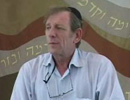- Sections
- Parashat Hashavua
- Torah Portion and Tanach
- Vayishlach
56
Now we will look at the highest level of acceptance our forefathers made and at its modern-day application. The people said at Sinai "na’aseh v’nishma" (we will do, and we will hear). Interestingly, the nation repeated a similar declaration at the time of Yehoshua (see Yehoshua 24:24).
The acceptance of the Torah after the Exodus from Egypt serves as a model for all generations of the process that a conversion candidate goes through. It consists of circumcision (for men), immersion in a mikveh, and acceptance of the mitzvot. Let us understand the place of acceptance of mitzvot, which all agree is a step in a properly done conversion.
If a candidate is unwilling to accept the mitzvot or even part of one mitzva, beit din may not accept him (Bechorot 30b). We would then expect that a candidate should have to learn all the laws so that it can be determined whether he is accepting everything. However, this is not so. The gemara (Sanhedrin 59a) derives from "Moshe commanded to us the Torah, a legacy to the congregation of Yaakov" (Devarim 33:4) that we are not allowed to teach Torah to a non-Jew. How can he accept that which we cannot teach him? The simple answer is that we are only supposed to teach him a small representative sampling of the mitzvot, based on which he makes his decision whether he is willing to accept all of the mitzvot. (Admittedly, nowadays it has been decided to be somewhat "lenient" and teach conversion classes much more than was once taught - see our opinion in Bemareh Habazak, vol. II). The normal process, though, is that acceptance of the mitzvot is done not after careful study but in the mold of "we will do and hear." He accepts to become a Jew with the understanding that this will obligate him in many ways that he only has a vague knowledge of. This leap of faith is what happened at Sinai. This is what Yehoshua demanded, and this is what is the essence of what converts are expected to do in all generations.
In our parasha we hear of Timna, the concubine of Elifaz son of Eisav, mother of Amalek. Chazal (Sanhedrin 99b) tell us that she sought to convert to (pre-Sinaitic) Judaism and was rejected by the forefathers. This mistake allowed Amalek to be born, with all of the pain that he brought upon us. Let us proclaim our intention to not unnecessarily close our hearts and distance those who sincerely come to enter under the wings of the Holy One Blessed be He and join Am Yisrael.

Parashat Hashavua: Kedoshim Teh’yu, Goy Kadosh – Are They Related?
Rabbi Yossef Carmel | Iyar 5785

The East Bank’s Big Four
Rabbi Yossef Carmel | 5774

The Right Pace to Leave a Holy Place
Parashat Beha'alotcha
Rabbi Yossef Carmel | 16 Sivan 5764

Parashat Hashavua: Who Called Out to Whom?
Rabbi Yossef Carmel | Nisan 5785

Parasha Vaera
Rabbi Shubert Spero | Tevet, 5763

Double Wrapping Food in a Treif Oven
Rabbi Daniel Mann | Kislev 4 5777

A Layman's Guide to some Halachic Aspects
Rabbi Yirmiyohu Kaganoff | 5773

A Layman's Guide to some Halachic Aspects
Rabbi Yirmiyohu Kaganoff | 5773

Parashat Hashavua: Kedoshim Teh’yu, Goy Kadosh – Are They Related?
Rabbi Yossef Carmel | Iyar 5785






